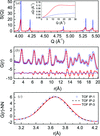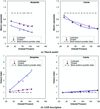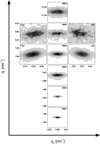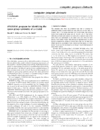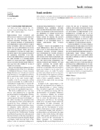issue contents
February 2005 issue

Cover illustration: Secondary electron image of a crystalline iron ore sinter phase, produced by heating to 1533 K and then cooling. Courtesy of N. V. Y. Scarlett, I. C. Madsen, M. I. Pownceby & A. N. Christensen [J. Appl. Cryst. (2004), 37, 362-368].
topical reviews
Open  access
access
 access
accessThis paper reviews methods of diffraction stress analysis of thin films and surface regions. The cases of macroscopically elastically isotropic and anisotropic specimens are dealt with.
research papers
A new approach is developed in order to determine single-crystal elasticity constants of a cubic phase from the analysis of a multiphase polycrystal. This inverse method is based on the coupling of a three-scale self-consistent micro-mechanical model with diffraction lattice strain measurements involving in situ pure elastic loading.
Structure and electron-density refinement of large molecules and macromolecules with the program MoPro, useful constraints, restraints, new functionalities and application examples, are described.
The effects of the instrument resolution functions and nanoparticle sizes on structural information obtained from the real-space pair distribution function are discussed using synthetic powder diffraction data.
A new diffractometer is described that requires no moving parts and can collect high-resolution X-ray data almost instantaneously. Example data are presented for InGaAs/GaAs and SiGe/Si multilayer structures.
The use of infrared imaging to locate crystals mounted in cryoloops cryocooled in a nitrogen gas stream at 100 K is demonstrated.
Samll-angle X-ray scattering of thin films with oriented two-dimensional cylindrical hexagonal mesostructures is evaluated.
Experimental observations and computational simulations suggest marked reduction in diffuso-convective disturbances in nanoliter-volume protein crystallization drops, leading to enhanced crystal quality as measured by diffraction and mosaicity.
The method called `rocking-curve imaging' (RCI) has recently been developed to visualize lattice imperfections in large crystals such as semiconductor wafers with high spatial resolution. In this article, an extension of the method is proposed by which dislocation densities in large-scale samples (semiconductor wafer crystals) can be quantified and their variation across the sample surface determined in an instrumentally simple way.
The intersect distribution of the regular tetrahedron has an algebraic form throughout the full range of distances.
The parameters controlling a hybrid Monte Carlo sampling algorithm, as applied to the problem of crystal structure determination from powder diffraction data, have been characterized with the aid of a system for distributed computing.
An X-ray diffraction study of the microstructure during phase transformations in an AISI type 300 steel is described.
The ability to recognize disulfide bridges automatically in electron density maps would be useful to both protein crystallographers and automated model-building programs. A computational method is described for recognizing disulfide bridges in uninterpreted maps based on linear discriminant analysis.
Open  access
access
 access
accessAn improved small-angle X-ray scattering method for determining asymmetric lipid bilayer structure in unilamellar vesicles is presented.
Silica aerogels were doped with cobalt, reduced, and studied with ultra-small-angle X-ray scattering. A scattering pattern rich in structure extends over nearly four orders of magnitude in q space, covering real space from 5 to 3000 Å, exposing micropores, mesopores and macropores for all aerogels.
The structural disorder of a quaternary zirconia single crystal in the system Zr–Y–O–N has been refined from diffuse neutron scattering data.
For a three-phase system, it is shown under what conditions the difference between scattering at two different X-ray wavelengths is the scattering of a two-phase system. From such measurements on a supported-metal catalyst, the particle size distribution of the metal particles is extracted.
A logarithmic function of bond orders, mathematically based on the Shannon entropy, has been proposed as a measure of distortion of MOn polyhedra and is found to correlate with the shortest-bond order within MO6 octahedra for MoO3 and other transition metal compounds.
The results of a comparative evaluation of the March model and the generalized spherical harmonic description for preferred orientation using X-ray powder diffraction data for molybdite (MoO3) and calcite show that the generalized spherical harmonic description generally provides superior figures-of-merit compared with the March model.
Open  access
access
 access
accessX-ray optical and resonant scattering tensors were derived from polarized fluorescence measurements on a selenated protein crystal. The knowledge of these tensors allows the optimization of the phasing signal in an anomalous diffraction experiment.
The mosaic structure of an (Al,Ga)N layer grown on (0001) sapphire showing natural ordering was studied by high-resolution X-ray diffraction (HRXRD) reciprocal-space mapping. The evaluation followed two paths: (i) a procedure based on the Williamson–Hall plot and (ii) a new approach based on the statistical diffraction theory.
Open  access
access
 access
accessA method for the weighting of structure factors from an incomplete and inaccurate model is described which relies on the fitting of smooth spline functions of resolution. This approach is used to investigate the stability of the problem when data are limited.
Rietveld texture analysis is applied to characterize the texture of polyphased superconducting cuprates and thermoelectric cobaltites. The anisotropy of the compounds is linked to the physical properties.
The coexistence of two-dimensional non-centered, two-dimensional centered rectangular columnar structures and three-dimensional tetragonal pore structure was detected in a mesoporous silica thin film on an Si wafer.
A combined reciprocal-space–real-space approach is described for solving macromolecular structures. The methodology has been found to be successful in redetermining the ab initio structures of six nucleic acids and proteins with data resolution up to 1.7 Å.
computer programs
CURVIS is a computer program capable of visualizing crystallographic structures and hyperbolic surfaces, and of calculating and representing their curvatures during phase transitions.
A method is presented for comparing crystal structures to identify similarity in molecular packing environments.
A new program, VALTOPO, for the determination of electrostatic properties from accurate X-ray diffraction data and for the analysis of experimental electron densities with the quantum theory of atoms in molecules, is presented.
computer program abstracts
The aim of this program is to identify the space-group symmetry and give the lattice parameters and Wyckoff positions of the atoms in a standard setting, no matter what setting the original information is given in.
book reviews
Free 

international union of crystallography
Free 



 journal menu
journal menu













